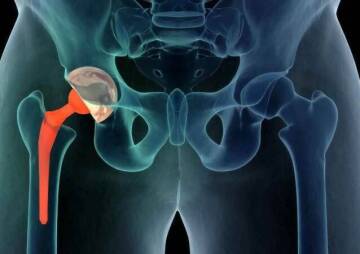-
Category
Craniomaxillofacial Surgery
Orthopedic Surgery
Spine Surgery
Orthopedic Implants
Hip Surgery
Knee Surgery
Pectus Excavatum
Bone Graft
Disinfectants
Healthcare
Find Out More About The Various Types Of Hip Replacement

The surgeon recommends one of the different types of hip replacements depending on the patient's needs and the damage's seriousness. In this article, you will be more familiar with this surgery.
Feeling pain in different parts of the body is always annoying and interferes with daily activities. Let's say you have pain in your hips when walking, sitting, and getting up, wearing shoes or socks, and it is difficult for you to do these everyday things. What would you feel? Having this problem is very annoying, and the life of those who have this problem is not normal. Diseases such as osteoarthritis and rheumatoid arthritis wear out body joints over time, especially hip joints. This causes severe pain and stiffness in the hip joint that makes daily tasks difficult. Today, there is almost a solution for all kinds of medical conditions, and hip replacement is one of the beneficial treatments for patients with hip joint problems. The surgeon recommends one of the different types of hip replacements depending on the patient's needs and the damage's seriousness. How well do you know the types of hip replacement? In this article, you will be more familiar with this surgery and the type of replacement that is best for you.
Anatomy Of The Hip Joint

The hip joint is a ball-and-socket joint and is one of the most complex and largest joints in the body. As shown in the picture, the ball, known as the Femoral Head, is the upper part of the femur or thighbone. The socket, also known as the acetabulum, is a part of the large pelvic bone. Under normal conditions, cartilage covers the surface of the ball and socket, thus preventing the joint from being worn and damaged. In other words, all joints' health depends on the cartilage, and any damage to the cartilage causes problems in the joints. Because if the cartilage is worn or damaged, the bones scrape together and cause severe pain and stiffness in the joints over time. Exactly what osteoarthritis does to the hip joint. Sometimes, the patient's condition and hip pain worsen with time, and no treatment will alleviate it. This is where the hip replacement will help these patients.
What Is Hip Replacement Surgery?
If your hip joint has been worn or damaged due to different reasons such as arthritis, aging, accident, or bad fall, you will have many treatment options. Doctors say hip replacement surgery is the last option to relieve this unpleasant condition because there are some non-surgical treatments. To treat hip injury and relieve pain caused by it, they prescribe some special exercises, physiotherapy, and corticosteroid injections. And if none of these methods work and patients already suffer from pain and stiffness even at rest, hip replacement surgery comes to help them. What is hip replacement surgery?
Hip replacement surgery, also known as hip arthroplasty, is a cutting-edge joint replacement procedure that normalizes many people's lives. In this surgery, doctors cut out the damaged parts of the pelvis and femur (thighbone) and replace them with an artificial joint or prosthesis. Patients will be relieved of joint pain and able to return to their everyday lives with the help of this prosthesis. But remember that an artificial joint won't work as a healthy joint for you because it's made of metal and plastic, so everyday wear and tear will cause it to wear out after a while. Although hip replacement will improve patients' quality of life, there will still be limitations in some activities.
Types of Hip Replacement

Hip replacement surgery, along with knee replacement, is the most common type of joint replacement surgery. According to statistics, approximately 300,000 hip arthroplasties are performed in the United States each year. This number is increasing dramatically from year to year. Not all hip arthroplasties are
the same, and there are three types of hip replacement; Total hip replacement, partial hip replacement, and Hip Resurfacing. You may be wondering about the differences between these types of hip replacements to see which one is right for you. Each of these replacement types is described in detail below:
Total Hip Replacement
As the name suggests, the hip joint's entire structure is replaced with an artificial joint in total hip replacement surgery. In this procedure, surgeons insert a stem inside the thighbone for stability and then replace the natural ball and socket with artificial ones. This operation is the best treatment option for people over the age of 70 and whose hip joints are entirely damaged. Total hip replacement is also more common than other types of hip replacement.
Partial Hip Replacement
In this type of hip replacement, only part of the hip joint is replaced, and it is common in young people. The purpose of partial hip replacement surgery is to replace the femoral head, which is the ball at the top of the femur, with a ceramic or metal ball. In this operation, the joint's socket remains intact, which is a significant advantage of this type of hip replacement. Doctors recommend this procedure for patients with problems such as hip fractures.
Hip Resurfacing
This form of surgery typically involves replacing artificial cartilage rather than removing some portion of the joint. In this manner, the surgeon removes the damaged part of the natural bone ball and then resurfaces it with a smooth metal coating. Most patients are fans of this replacement, but it is not suitable for everyone as it is an appropriate treatment for reducing pain due to cartilage loss.
You may ask which hip replacement method is the best. It is up to your doctor to answer this question because they are fully aware of the type of disease and the extent of your joint damage. Besides, it is necessary to choose a professional and experienced doctor to perform this procedure because a bit of ignorance can have irreparable consequences. As you probably know, hip replacement has a challenging and complex surgical process and recovery period, so you need to be careful.
Types of Hip Prothesis
In previous articles, we mentioned that the artificial knee joint is made of metal and plastic. But hip implants are not only made of metal and plastic, and their materials are a little bit different. For example:
- "Ceramic-on-Metal" prosthesis is almost new, and its use has been approved since 2011. The ball in this form of implant is made of ceramic, and the socket is covered with metal.
- "Metal-on-Polyethylene": This is the most traditional form of the prosthesis; the ball is made of metal, and the socket is covered with a plastic cover; it has been in use since about 1960. However, doctors say the plastic part produces debris after some time, leading to implant failure and a condition called osteolysis.
- "Ceramic-on-Ceramic": As the name suggests, these types of implants are made of ceramic parts and ceramic lining. According to research, CoC implants' overall survival rate was around 90% and has recently risen to over 91%.
- "Metal-on-Metal": In the past, manufacturers of hip prostheses claimed that metal was highly durable, so prostheses were entirely made of metal. However, research has shown that metal produces particles that are highly hazardous to health and cause a condition known as metal poisoning or 'Metallosis.' That is why MoM implants are no longer available in the US market.
Total Hip Replacement Surgical Methods
Are all hip replacement types done with only one surgical method? Of course not. Since total hip replacement is the most common type, surgical approaches to perform this are different. Orthopedic surgeons usually use two surgical methods for performing hip replacement; the anterior method or muscle-sparing hip replacement and the posterior method. So what is the difference between the two methods? The surgical procedure is almost the same in both methods. The only difference is the incision site where the operation will begin. In the anterior method, surgeons make an incision in front of the hip, but in the posterior approach, the incisions are made from the back of the hip. The posterior approach is the most common method since the scar would not be visible.
Hip Replacement Complications
When people decide to have surgery, the fear and stress of surgery, as well as the side effects during and after the surgery, are very worrying for them. Statistics show that most hip replacement candidates are searching for postoperative complications and recovery period challenges. In general, patients do not experience severe side effects after hip replacement, and if you choose your doctor carefully, you will not have any problems. Possible side effects include:
- Infection is rare in hip replacement surgery and usually occurs at the incision site or near the new hip in deeper tissue.
- Blood clots can form in your leg veins, and it can be life-threatening if some of this clot breaks up and is carried by the bloodstream to your lungs and heart. But don't worry, the doctor will prescribe anticoagulants to reduce the risk of these complications to almost zero.
- Prosthetic dislocation usually occurs a few months after surgery, and part of the new joint, such as a ball or socket, may be dislocated.
- Fractures may occur during surgery on healthy parts of your hip joint. These fractures are either so minor that they heal on their own after a while; otherwise, the doctor will have to correct them in some way.
- Nerve damage around the area where the artificial implant is placed is very rare. But if it happens, it causes numbness and weakness.
- Loosening is another rare complication of hip replacement. In this case, the new joint is not fixed well, and after a while, the person will feel severe pain. If this problem occurs, doctors have to perform revision surgery and fix the prosthesis.
To Sum Up
Hip replacement surgery is a highly successful and efficient treatment for pain and discomfort caused by hip arthritis. And it is done almost every day worldwide, making patients' lives comfortable for several years. Hip replacement types usually last about 10-15 years, and then you need to renew your artificial joints. Before surgery, it is best to assess your expectations of hip replacement surgery and to learn more about the cost of hip replacement and its side effects. Under these conditions, you can prepare for the surgery without stress and in a good mood.
Reference: hss.edu



